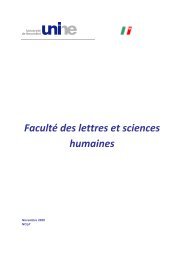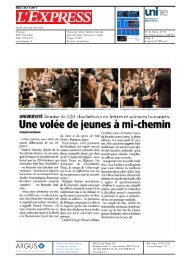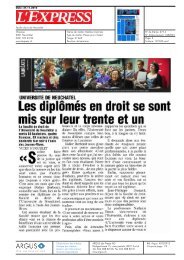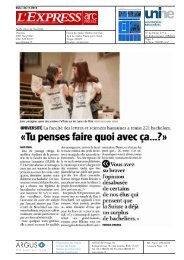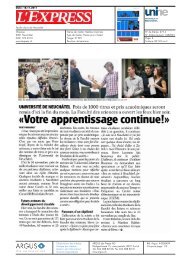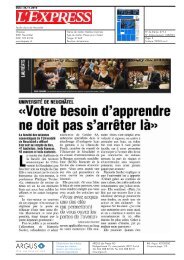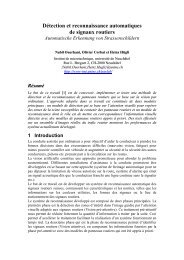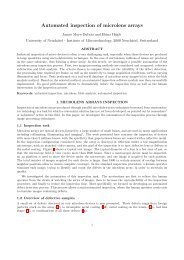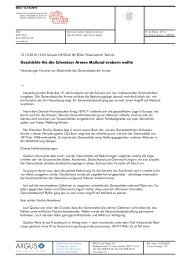A configuration assistant for versatile vision-based inspection systems
A configuration assistant for versatile vision-based inspection systems
A configuration assistant for versatile vision-based inspection systems
You also want an ePaper? Increase the reach of your titles
YUMPU automatically turns print PDFs into web optimized ePapers that Google loves.
Header <strong>for</strong> SPIE use<br />
A <strong>configuration</strong> <strong>assistant</strong> <strong>for</strong> <strong>versatile</strong> <strong>vision</strong>-<strong>based</strong> <strong>inspection</strong> <strong>systems</strong><br />
Olivier Hüsser<br />
Institute of Microtechnology<br />
University of Neuchâtel<br />
Rue A.-L. Breguet 2<br />
2000 Neuchâtel<br />
olivier.huesser@imt.unine.ch<br />
Heinz Hügli<br />
Institute of Microtechnology<br />
University of Neuchâtel<br />
Rue A.-L. Breguet 2<br />
2000 Neuchâtel<br />
heinz.hugli@imt.unine.ch<br />
ABSTRACT<br />
Nowadays, <strong>vision</strong>-<strong>based</strong> <strong>inspection</strong> <strong>systems</strong> are present in many stages of the industrial manufacturing process. Their<br />
versatility, which permits to accommodate a broad range of <strong>inspection</strong> requirements, is however limited by the time<br />
consuming system setup per<strong>for</strong>med at each production change. This work aims at providing a <strong>configuration</strong> <strong>assistant</strong> that<br />
helps to speed up this system setup, considering the peculiarities of industrial <strong>vision</strong> <strong>systems</strong>. The pursued principle, which<br />
is to maximize the discriminating power of the features involved in the <strong>inspection</strong> decision, leads to an optimization<br />
problem <strong>based</strong> on a high dimensional objective function. Several objective functions <strong>based</strong> on various metrics are proposed,<br />
their optimization being per<strong>for</strong>med with the help of various search heuristics such as genetic methods and simulated<br />
annealing methods. The experimental results obtained with an industrial <strong>inspection</strong> system are presented. They show the<br />
effectiveness of the presented approach, and validate the <strong>configuration</strong> <strong>assistant</strong> as well.<br />
Keywords: Visual <strong>inspection</strong>, <strong>vision</strong> <strong>systems</strong>, automatic setup, system <strong>configuration</strong>, heuristic search, decision, objective<br />
function<br />
1. INTRODUCTION<br />
In the automatic <strong>inspection</strong> field, advanced visual <strong>inspection</strong> <strong>systems</strong> per<strong>for</strong>m a large and ever growing number of controls.<br />
These <strong>systems</strong>, however, require some tuning in order to per<strong>for</strong>m efficiently on a specific task. Given the increasing<br />
complexity of the system, manual tuning becomes a major problem of an operator using such a system. Means <strong>for</strong> automatic<br />
tuning are required.<br />
Automatic optimization tasks in the <strong>vision</strong> field are numerous. Some example tasks recently investigated are: contour<br />
tracking with snakes 1 ; pattern recognition in association with markov random field representations 2 ; image restoration 3 ;<br />
geometric trans<strong>for</strong>mation estimation by iterative closest point methods 4 . Among the few papers related to visual <strong>inspection</strong><br />
<strong>systems</strong> and their optimization, the paper by Daniel and West 5 describes a method <strong>for</strong> modeling shape variations of <strong>for</strong>ged<br />
devices from samples. Using eigenvectors and an optimization algorithm <strong>based</strong> on an energy function he describes a way to<br />
unveil the mapping between process control parameters and shape de<strong>for</strong>mation of the <strong>for</strong>ged device allowing to optimize<br />
the production process. In the present paper, the focus is set on the optimization of a visual <strong>inspection</strong> system in order <strong>for</strong> it<br />
to minimize its error rate.<br />
A visual <strong>inspection</strong> system consists mainly of two parts: an image analysis and a decision part. The image of the device to<br />
be inspected, Y, is first analyzed with help of image analysis tools that produce a set of measurements M. This measurement<br />
vector is then classified by the decision module giving the final decision ω. Both steps may involve several parameters P<br />
that influence the output (decision) of the system.<br />
In order to tune the system, human operators execute the following supervised learning procedure. First, a certain number of<br />
good and bad representatives is drafted among the devices to be inspected. Then the visual <strong>inspection</strong> is per<strong>for</strong>med and,<br />
depending on the system’s decision, some parameters might be modified. Inspections and modifications are per<strong>for</strong>med until<br />
experimental decisions match the a priori good/bad partition.<br />
This setup process is not easy and can be time consuming. Furthermore it is approximate, in the sense that no hint on the<br />
confidence of decisions is available. In order to remedy these shortcomings, we developed a <strong>configuration</strong> <strong>assistant</strong> that is<br />
presented in this paper. The <strong>configuration</strong> <strong>assistant</strong> is designed to per<strong>for</strong>m the parametric tuning automatically. The pursued<br />
idea is not only to enhance the decision module, as it is often the case, but also to maximize the discriminating power of the<br />
measurements.
The per<strong>for</strong>mance of the visual <strong>inspection</strong> must be <strong>for</strong>mulated in a way that permits a comparison between the expected and<br />
experimental results. Somehow, this comparison must be quantifiable and the resulting quantity be pertinent. We call this<br />
quantity the objective function F. This scalar function over the parameters of the system should trustfully represent the<br />
realization of the expected results, must be reliable and in<strong>for</strong>mative altogether. Thus, in order to find the best <strong>configuration</strong><br />
<strong>for</strong> the system the idea is to use the objective function to measure its per<strong>for</strong>mance and to use search heuristics <strong>for</strong> exploring<br />
the parametric space spanned by P. Practically, a “good enough” solution is sufficient.<br />
This paper focuses on the design of a <strong>configuration</strong> <strong>assistant</strong> <strong>for</strong> an <strong>inspection</strong> system whose decision module consists of a<br />
so-called and-classifier. This type of decision is widespread in the industrial <strong>inspection</strong> field where checked devices have to<br />
satisfy multiple mandatory constraints.<br />
The paper is organized as follows. Next section describes the <strong>inspection</strong> system. We present in section 3 some ways to<br />
define the objective function appropriate <strong>for</strong> an and-classifier and present the methods used to per<strong>for</strong>m the supervised<br />
learning. Section 4 presents the particular case of the <strong>configuration</strong> <strong>assistant</strong> applied to IC marking <strong>inspection</strong>. Results<br />
obtained with real data are presented in section 5.<br />
2. INSPECTION SYSTEM<br />
Consider the <strong>inspection</strong> system of figure 1 which visually analyzes the image Y and provides a decision <strong>for</strong> an object. The<br />
analysis of the image may involve several parameters P that influence the resulting measurements M. The decision system<br />
using the measurements takes a decision ω about the inspected device. The decision rule may also have some degrees of<br />
freedom T that influence the outcome.<br />
Industrial visual <strong>inspection</strong> <strong>systems</strong> determine whether a produced device satisfies some requirements. Most of the time, all<br />
of these requirements have to be satisfied in order <strong>for</strong> a device to be labeled as good. These requirements are said to be<br />
mandatory: a device must satisfy the first requirement and the second and all others to be accepted. Hence the name of andclassifier<br />
used here to designate the decision stage.<br />
Given the definition of figure 1 the requirements are <strong>for</strong>mulated with respect to some measurements M and usually take the<br />
<strong>for</strong>m of thresholds T i . In addition, a convenient <strong>inspection</strong> system, has normalized measurements with high values <strong>for</strong> good<br />
devices. The decision rule of such a classifier is written as:<br />
⎧ accepted if Mi > Ti<br />
∀ i,i = 1,2,..., n<br />
ω = ⎨<br />
⎩rejected<br />
otherwise<br />
(1)<br />
Y<br />
Image analysis<br />
M<br />
Decision<br />
(And-classifier)<br />
ω<br />
P<br />
T<br />
Inspection<br />
Figure 1: Structure of an <strong>inspection</strong> process
Given a set of devices represented by their digital image Y={Y 1 , Y 2 , …, Y n }, and given an a priori classification of this set<br />
of devices by a human operator ω ∗ (Y)={ ω ∗ (Y 1 ), ω ∗ (Y 2 ), …, ω ∗ (Y n )} the learning set is defined as Ω L ={Y, ω ∗ (Y)}. The<br />
learning set is the union of two subsets: the good and the bad device’s subsets. They are denoted here by Ω x (good) and Ω o<br />
(bad).<br />
Given the learning set, the goal is to find parameters P and T such that expected <strong>inspection</strong> per<strong>for</strong>mance on future objects is<br />
optimized. Next section presents objective functions as a measure <strong>for</strong> the expected per<strong>for</strong>mance as well as search methods<br />
<strong>for</strong> finding the optimum.<br />
3. OBJECTIVE FUNCTIONS AND SEARCH METHODS<br />
This section presents objective functions F used to measure the quality of the parameter’s <strong>configuration</strong> in a system whose<br />
decision stage is an and-classifier. It then introduces the search methods used to find the maximum of F, i.e. to find the best<br />
parametric <strong>configuration</strong> according to F.<br />
3.1. Objective Functions<br />
To optimize the expected system’s per<strong>for</strong>mance in a general context, the available learning set will be used. The goal is then<br />
to optimize the system’s per<strong>for</strong>mance over this learning set. A first and obvious way to evaluate this per<strong>for</strong>mance is the<br />
recognition rate, R, defined as the fraction of correct decisions. It is normalized and it takes its maximum value of 1 if and<br />
only if all devices of the learning set are correctly classified. Although R represents the aptitude of the system on the<br />
learning set, it is not a good function <strong>for</strong> practical use. First because it is quantified on a small number of levels<br />
(=Card{Ω L }) and is thus a rather rough function of the <strong>configuration</strong>. Furthermore it gives no hint on the confidence in the<br />
decision taken by the system. The main idea on the way to find a better per<strong>for</strong>mance measurement is to consider rather a<br />
function of the learning set’s measurements F({M} ΩL ) than a function of the learning set’s partition F(ω).<br />
Two hypotheses about the system are made. First, it is believed that the learning set has been selected with care. Secondly,<br />
the per<strong>for</strong>med image analysis is supposed to be adequate to provide discriminant measurements. If these two conditions are<br />
satisfied, then it is possible using the degrees of freedom of the system to find a <strong>configuration</strong> that per<strong>for</strong>ms faultless with<br />
the learning set (R=1). The optimal margin classifier idea used by Vapnik 6 has been employed here in order to minimize the<br />
risk of a sample’s misclassification over the learning set. It is also expected that this approach ensures a stable system<br />
behaving faultless with new devices (generalization) as long as they have representatives within the learning set.<br />
3.1.1 Objective function <strong>for</strong> 1-dimensional measurements<br />
Figure 2 displays the measurements M y of a learning set of devices <strong>for</strong> a 1-dimensional pseudo and-classifier. The “x”<br />
symbols are the measurements of the Ω x subset. Conversely, the “o” symbols are the measurements of the Ω o subset. The<br />
vertical line denotes a fixed threshold T that has been preset.<br />
2 . F’<br />
O O O O O<br />
X X X X X X<br />
F<br />
M<br />
T<br />
Figure 2: Objective function <strong>for</strong> 1-dimensional measurement space<br />
The objective function F <strong>for</strong> the optimal margin is defined here as the minimum distance between a measurement M y and<br />
the threshold T conditional to an absolutely correct classification:<br />
⎧max(0,<br />
M<br />
Y<br />
− T ) <strong>for</strong> Y ∈ Ω<br />
x<br />
Given the measurements margin δ ( M<br />
Y<br />
, T ) = ⎨<br />
. (2)<br />
⎩max(0,<br />
T − M<br />
Y<br />
) <strong>for</strong> Y ∈ Ωo
The objective function F takes the <strong>for</strong>m F = minδ<br />
( M , T )<br />
(3)<br />
Y∈Ω<br />
L<br />
Y<br />
If the threshold is variable it can be optimized. The best position is at mid-distance of the closest pair of bad/good<br />
measurements. According to it, the objective function takes the <strong>for</strong>m<br />
1<br />
F'<br />
= ⋅ max(0;min M<br />
Y<br />
− max M<br />
Y<br />
) . (4)<br />
2<br />
Y∈Ω<br />
x Y∈Ω o<br />
Note that the value of both F and F’ is 0 when good and bad devices are not separable.<br />
3.1.2 Objective function <strong>for</strong> n-dimensional measurements<br />
The objective function <strong>for</strong> multidimensional and-classifiers relies on the same concepts as <strong>for</strong> the 1-dimensional case. Some<br />
definitions must be given in order to define its variants.<br />
Given the decision space D spanned by the set of measurements, we define the acceptance space A of the classifier as the<br />
subspace of D where the <strong>inspection</strong> system considers the measurements as belonging to an acceptable device. In the<br />
complementary rejection space the system rejects the devices: A = D – A . The partition in A and A of an andclassifier<br />
is defined by the n thresholds.<br />
The objective function should reflect how far the measurements are from a wrong classification, i.e. from the wrong, or<br />
opposite, subspace. The minimum distance is still the main concern and so, the following objective function F is defined<br />
<strong>based</strong> on above definition: F is equal to the minimum distance, over the learning set, of a measurement to its opposite<br />
subspace.<br />
This can be either the distance of a good device to A , or the one of a bad device to A :<br />
F =<br />
⎡min<br />
M<br />
⎢⎣ Y∈Ω<br />
o<br />
Y<br />
; A ;min M A ⎤<br />
Y<br />
;<br />
Y∈Ω<br />
x ⎥⎦<br />
min , (5)<br />
where “|| ||” denotes the minimum distance between a point and a subspace. Note that “|| ||”=0 when the point belongs to the<br />
subspace. The notion of distance “|| ||” is related to a metric. The distance functions take the following generic <strong>for</strong>m <strong>for</strong> a L n -<br />
1<br />
n<br />
= . In one-dimensional case all metrics are equivalent, and so the definition of F is unique. This is<br />
n<br />
∑ Δ<br />
metric: ( ) n<br />
not the case in n-dimensional spaces where objective functions will take distinct <strong>for</strong>ms depending on the chosen metric.<br />
Figure 3 shows in 2-dimensional space the equipotential lines of F defined with 3 different metrics: L 1 , L 2 , L ∞ . It is visible<br />
that they only differ when multiple measurements compose the distance.<br />
M2<br />
X<br />
X<br />
A<br />
X<br />
X<br />
M2<br />
X<br />
X<br />
A<br />
X<br />
X<br />
M2<br />
X<br />
X<br />
A<br />
X<br />
X<br />
T2 || || 1 =0<br />
T2<br />
|| || 2 =0<br />
T2<br />
|| ||inf=0<br />
o<br />
o<br />
o<br />
o<br />
o<br />
o<br />
o<br />
o<br />
o<br />
o<br />
o<br />
o<br />
o<br />
o<br />
o<br />
o<br />
o<br />
o<br />
T 1<br />
M1<br />
T 1<br />
M1<br />
T1<br />
M1<br />
Figure 3: Acceptance subspace & contour plot of objective functions <strong>based</strong> on L 1 , L 2 , L ∞<br />
Given the good devices margin, defined as the minimum distance of any good device to A :<br />
[ [ max(0 M<br />
Yi<br />
− Ti<br />
]<br />
δ (6)<br />
x<br />
= min min ;<br />
Y ∈ Ω i<br />
x
and given the margin components δ Yi <strong>for</strong> a bad device Y and component i:<br />
( 0 M )<br />
= max ;T −<br />
(5) is rewritten with different metrics and fixed thresholds T i :<br />
δ<br />
Yi<br />
i Yi<br />
,<br />
o<br />
Y ∈ Ω<br />
(7)<br />
F<br />
1<br />
⎡ ⎛ ⎞ ⎤<br />
= min⎢min⎜∑δ Yi ⎟;<br />
δ<br />
x ⎥<br />
Y∈Ω<br />
o<br />
⎣ ⎝ i ⎠ ⎦<br />
(8)<br />
F<br />
2<br />
F<br />
∞<br />
⎡ ⎛<br />
2 ⎞ ⎤<br />
= min⎢min<br />
⎜ ∑δ ⎟<br />
Yi<br />
; δ<br />
x ⎥<br />
Y∈Ω<br />
o<br />
⎣ ⎝ i ⎠<br />
⎦<br />
= min⎡min max<br />
⎢⎣ Y∈Ω<br />
o<br />
[ ( δ )] ⎤<br />
Yi<br />
; δ<br />
x<br />
i ⎥⎦<br />
(9)<br />
(10)<br />
If the thresholds are variable they can be optimized according to the measurements of Ω L . The resulting acceptance<br />
subspace A must include all Ω x measurements and exclude all Ω o measurements. To <strong>for</strong>mally define this constraint and have<br />
a convenient way to calculate the objective function, we define here a minimum acceptance space A *. Given the smallest<br />
measurement components of the good subset<br />
A * is the subspace whose points P satisfy P ≥ M<br />
min ∀i<br />
.<br />
i<br />
xi<br />
Y∈Ω x<br />
( )<br />
min<br />
M xi<br />
= min M<br />
So, the F’ objective function is defined similar to the 1-dimensional case as half of the minimum distance of all Ω o<br />
measurement to A ∗ .<br />
1<br />
F'<br />
= ⋅ min M<br />
Y<br />
; A*<br />
2 Y∈Ωo<br />
(12)<br />
Figure 4 displays acceptance spaces <strong>for</strong> a bi-dimensional classifier. Left hand displays the acceptance space A used with<br />
fixed thresholds and right hand displays the minimum acceptance space A ∗ used with variable thresholds.<br />
Yi<br />
(11)<br />
M 2<br />
X<br />
X<br />
X<br />
A<br />
X<br />
X<br />
M 2<br />
A*<br />
X X X<br />
X<br />
X<br />
T 2<br />
o<br />
o<br />
o<br />
o<br />
o<br />
X<br />
o<br />
M X2<br />
min<br />
T 2<br />
o<br />
o<br />
o<br />
o<br />
o<br />
X<br />
o<br />
T 1<br />
M 1<br />
T 1<br />
M X1<br />
min<br />
M 1<br />
Figure 4: Acceptance subspaces A and A * with fixed (left) or tunable thresholds (right)
given the double-margin components :<br />
( 0; M − M )<br />
′ Yi<br />
= max<br />
min<br />
xi<br />
δ '<br />
, (13)<br />
Yi<br />
the (8), (9), (10) equivalent functions with configurable thresholds are :<br />
⎛ ′ ⎞<br />
F<br />
1'<br />
= 0.5 ⋅ min⎜∑δ<br />
'<br />
Yi<br />
⎟<br />
Y∈Ω<br />
o<br />
⎝ i ⎠<br />
⎡ ′<br />
F2 ' = 0.5 ⋅ min⎢<br />
∑δ<br />
Yi<br />
Y∈Ω<br />
o<br />
⎢⎣<br />
i<br />
2<br />
⎤<br />
⎥<br />
⎥⎦<br />
(14)<br />
(15)<br />
3.2. Search Methods<br />
⎡ ′<br />
F ' = 0.5 ⋅ min max( δ '<br />
Yi<br />
Y∈Ω<br />
o<br />
⎢⎣ i<br />
∞<br />
)<br />
Objective functions described be<strong>for</strong>e are defined over the measurements of the learning set which are depending on the<br />
parameters of the <strong>configuration</strong>. This dependency can take any <strong>for</strong>m and is not restricted to be analytical. The number of<br />
parameters is not specified either. So practically objective functions of unknown and different nature will be found. The<br />
difficulty is to maximize over the set of possible <strong>configuration</strong>s an objective function F (P,T) of unknown nature. To do<br />
this we will use methods that are recognized as robust and efficient in such situations: genetic algorithms and simulated<br />
annealing. A third method called enhanced random is presented and also considered.<br />
One concern with the employed methods, is to avoid the replication of the problem to be solved. What cannot be tolerated,<br />
is a search method that would require some choices in order to function properly. It would just shift the parametric<br />
<strong>configuration</strong> problem to another level. Search methods must there<strong>for</strong>e be designed with versatility in mind in order <strong>for</strong><br />
them to cope reasonably well with various tasks.<br />
3.2.1 Genetic algorithm (GA)<br />
For a general description of genetic algorithms we refer to existing documents 7, 8 and will restrict ourselves to the<br />
description of the particular implementation of the simple genetic algorithm used in this work. Its initial population is<br />
selected randomly over {P}. The evaluation, or fitness function, is the objective function previously discussed. The roulette<br />
wheel selection scheme is applied. A non elitist replacement scheme associated with a high mutation rate (P mut =0.1) and an<br />
explorative crossover method prevent the GA’s stagnation. We applied two crossover methods. First a standard multiple<br />
point crossover with a probability of 10% and more frequently (90%) a linear crossover scheme. The linear method creates<br />
two offspring located on the extended segment that connects both parents in {P} space. This process is illustrated in figure<br />
5. The probability density is constant all along the segment.<br />
⎤<br />
⎥⎦<br />
(16)<br />
P j<br />
Figure 5: linear crossover process of the GA<br />
P 1<br />
P 2<br />
5/6<br />
1<br />
“child line”<br />
1/6<br />
0<br />
P i<br />
Population size is constant and small: 20 individuals. This choice allows a large number of generations to take place until<br />
the time limit stopping criterion is reached.
3.2.2 Simulated annealing method (SA)<br />
The name of this method comes from its relationship with physical <strong>systems</strong> and their equilibrium states. The <strong>configuration</strong><br />
is considered here as a set of possible states <strong>for</strong> the <strong>inspection</strong> system. Associated with each state is a scalar value called<br />
energy. Here, the energy of a state P is ε(P)=1-F(P). Transition from one state to another is given a probability that depends<br />
on their relative energy values and a parameter called temperature. The algorithm per<strong>for</strong>ms at each step such a transition.<br />
This process is called stochastic relaxation 3 . The chosen algorithm works with a binary temperature schedule, alternating<br />
T=0 and T=∞. Figure 6 shows the flow diagram of the SA method: Starting from a randomly selected <strong>configuration</strong> (T=∞),<br />
gradient descent (T=0) is per<strong>for</strong>med until a local minimum is reached; then if the stopping criterion is not satisfied, the<br />
process starts over.<br />
START<br />
Stochastic<br />
relaxation<br />
with T=∞<br />
End<br />
criterion<br />
reached<br />
END<br />
Stochastic<br />
relaxation<br />
with T=0<br />
Local<br />
minimum<br />
Figure 6:Temperature schedule of SA<br />
3.2.3 Enhanced random method (ER)<br />
This method combineds a random selection scheme with a probability density estimation.<br />
P<br />
F( P ) > 0<br />
F( P ) = 0<br />
Figure 7: modification of ρ(P)<br />
The principle of this algorithm is to use the past results to increase the probability of finding a good solution in the future.<br />
At the beginning, as no result is available, the first parametric vector P is chosen randomly over the whole parametric space<br />
of the permitted values specified by the user <strong>for</strong> the hidden <strong>configuration</strong> {P}. This random process is <strong>based</strong> on the<br />
assumption that all points P i in {P} have the same probability to be a good solution and there<strong>for</strong>e to be chosen. In other<br />
words, the probability density ρ (P) is uni<strong>for</strong>m over {P}. Then, to enhance the efficiency, the probability density is modified<br />
according to the results already obtained. This process uses the Parzen windows 9 technique to approximate an unknown
density function of a data set over a variable. It uses a simplified ρ( P r<br />
) = ρ ( ) that assumes the independence of the<br />
parameters. This gives a star-shaped modification of ρ (P) with a maximum at center (see figure 7). Of course, a maximum<br />
limit has to be set <strong>for</strong> ρ (P) in order to prevent a possible automatic selection of good tested settings.<br />
4. AN IC MARKING INSPECTION SYSTEM<br />
The experimental part is per<strong>for</strong>med on an industrial <strong>inspection</strong> system in the context of visual <strong>inspection</strong> of integrated<br />
circuits markings. The <strong>inspection</strong> process checks the correctness of markings found on top of molded integrated circuit<br />
packages. These markings are either painted or laser burnt on the chip. An example of marking is shown in figure 8. The<br />
production environment is characterized by a high device throughput and a limited marking precision. In order to deal with<br />
these constraints, the visual <strong>inspection</strong> system possesses a number of efficient and <strong>versatile</strong> measurement and analysis tools<br />
that must be configured <strong>for</strong> optimal operation.<br />
∏<br />
i<br />
i<br />
p i<br />
Figure 8: SOT device inspected in a production line<br />
Decision to accept or reject a device <strong>for</strong> an eventual marking defect is <strong>based</strong> on two measurements : contamination factor<br />
M 1 and missing factor M 2 . These measurements are calculated relatively to a reference (golden unit). Given Y and R the<br />
test and reference markings, we define the intersection pattern I=R∩Y(see figure 9). With the associated surfaces S Y , S R,<br />
and S I the measurements are written:<br />
S<br />
M =<br />
S<br />
I<br />
1<br />
,<br />
X<br />
S<br />
I<br />
M<br />
2<br />
= . (17), (18)<br />
S<br />
R<br />
Figure 9: reference, test, and intersection patterns<br />
Both measurements are normalized. The contamination factor represents the fraction of the inspected marking’s surface that<br />
matches the reference and missing factor the fraction of the reference’s surface that is covered by the inspected device. Of<br />
course, reference and test are superposed during a parametrized preprocessing step.<br />
These measurements are simple. Their computation is fast and allows a high <strong>inspection</strong> throughput. They are <strong>versatile</strong> and<br />
apply to a broad spectrum of markings. Their disadvantage is that it is not obvious to set limit value <strong>for</strong> the acceptance of a<br />
marking. This led us to consider measurements thresholds as belonging to the <strong>configuration</strong> of the system, and accordingly<br />
to set their values with the <strong>configuration</strong> <strong>assistant</strong>. A device’s marking is rejected unless (M 1 > T 1 ) and (M 2 > T 2 ).
The <strong>configuration</strong> associated with these measurements has 6 parameters. With the two configurable decision thresholds, it<br />
makes an 8-dimensional parametric space P={P 1-6 ;T 1-2 }.<br />
Most of these parameters are concerned with the image processing of the inspected device. The effect of these parameters<br />
on the measurements is too complex to be analyzed. For example, P 1 and P 2 are offset values <strong>for</strong> the grayscale thresholds<br />
used when binarizing the reference and inspected images. The table below shows that the variation of P 1 and P 2 affects M 1<br />
and M 2 in a way that is difficult to describe.<br />
S R S X S I M 1 M 2<br />
P 1 - ?<br />
P 2 - ?<br />
Table 1 : Influence of system parameters on measurements<br />
In essence it shows how increasing values of P 1 and P 2 affect the parameters. The arrow represents a<br />
decreasing value and ‘-‘ a constant value; the mark ? denotes an unpredictable effect depending of the particular test<br />
image and reference. The fact is that the ways P 1 affects M 2 and P 2 affects M 1 cannot be predicted. So, varying only these 2<br />
parameters will already lead to totally unpredictable measurement changes. Far more complex is their dependance on all 6<br />
parameters.<br />
Here comes the <strong>configuration</strong> <strong>assistant</strong> ! It is used as follows.<br />
At beginning of a new production run, a selection of good and bad markings is chosen as a learning set. Each component of<br />
P is given a range of possible values resulting in a subspace P * of P. The automatic <strong>configuration</strong>, over P * , of the marking<br />
<strong>inspection</strong> system is then launched. It operates with one of the search methods described in 3.2 and with the objective<br />
functions defined previously (14), (15), (16). The automatic <strong>configuration</strong> search stops after a given amount of time and<br />
delivers the best <strong>configuration</strong> to be used <strong>for</strong> the marking <strong>inspection</strong>. The system is then ready to inspect the produced<br />
devices.<br />
5. EXPERIMENTS<br />
Experiments were conducted with several data sets and varying number of <strong>configuration</strong> parameters. All the search methods<br />
were tested long enough to gather statistically significant experimental results.<br />
5.1. Data<br />
The images of the devices were taken by standard RS170 monochrome imagers in our labs and in the production line of a<br />
customer. In the production line experiment, samples of “clean” markings were selected to make the Ω x subsets whereas Ω o<br />
subsets gathered really rejected printed markings. In the experiment, due to the unbalanced number of good versus bad<br />
provided markings at disposal, we had to “create” some bad devices. Synthetic defects are defects that were artificially done<br />
on good markings. These voluntary defects may take the <strong>for</strong>m of scratches, written over, false marking, white/black tape<br />
stripes pasted over the marking.<br />
3 data sets are considered as described in table 2:<br />
“74X” data set “SOT” data set “Casablanca” data set<br />
Origin Lab Lab Production line<br />
Type of defect Synthetic synthetic real<br />
# of parameters 3+2 4+2 5+2<br />
# of samples in Ω x /Ω o 10 / 10 21 / 36 20 / 20<br />
Table 2: Data sets used<br />
In this table, the number of parameters refers to the parameters automatically adjusted by the <strong>configuration</strong> <strong>assistant</strong>. These<br />
parameters are given possible discrete values belonging to a range; typically 10-20 allowed values per parameter. The 2<br />
additional parameters are the decision thresholds T i .
Figure 11 displays images of one “synthetic” defective, one good and one “real” defective devices.<br />
Figure 11: Images from inspected devices<br />
5.2. Nature of Objective Function<br />
The objective function measured with the Casablanca data set is plotted in figure 12 with 2 varying parameters. It is typical<br />
of the functions that were encountered in this work: it exhibits the three following characteristics. First the function takes<br />
zero value over the greatest part of the space. Secondly, the places where it takes non-zero values mostly <strong>for</strong>m some<br />
connected regions. Finally the objective function is rather “regular” over these interesting regions. Thus, it can be expected<br />
that intelligent search heuristics will take advantage of these regularities of the objective function.<br />
Figure 12: Objective function F <strong>for</strong> Casablanca data<br />
5.3. Search Methods Comparison<br />
A score is defined <strong>for</strong> further per<strong>for</strong>mance comparison of search methods. Given the objective function F(P), we define the<br />
normalized objective function as :<br />
F<br />
F n<br />
= r . (19)<br />
max F P<br />
[ {}]<br />
and call objective score of a search the value of the highest F n encountered during the search.<br />
To practically compute the objective score, an exhaustive search over the possible <strong>configuration</strong>s was first per<strong>for</strong>med to<br />
gather the complete in<strong>for</strong>mation about F(P). Of particular interest is the global maximum of F over {P} used in (19).<br />
In order to compare the per<strong>for</strong>mance of the search methods, the mean objective score is plotted versus time (number of<br />
trials). A mean has to be used because of the intrinsic randomness of the used search methods, so only statistical results are<br />
significant. Figure 13 represents the mean objective score <strong>for</strong> the 3 search methods. The mean is computed over 100 trials.<br />
Results of a random search method are also displayed <strong>for</strong> comparison. The figure shows that the intelligent search methods<br />
GA and SA significantly outper<strong>for</strong>m random selection. Enhanced random is less efficient.
This plot gives also an indication of the acceleration that a method brings <strong>for</strong> the <strong>configuration</strong> of the system. With the<br />
intelligent search methods, the <strong>configuration</strong> becomes nearly optimal (normalized score>0.95) already after only a small<br />
number of iterations. Typical speedup of SA or GA methods against random method are between 5-20 when approaching<br />
near optimal solutions. The speedup factor when compared with an exhaustive search of all possible <strong>configuration</strong>s is<br />
important (about 100 <strong>for</strong> 5 parameters ).<br />
1<br />
0.9<br />
0.8<br />
0.7<br />
Supervised Learning with different search methods (Casablanca data set)<br />
GA<br />
SA<br />
ER<br />
Random<br />
0.6<br />
F n<br />
0.5<br />
0.4<br />
0.3<br />
0.2<br />
0.1<br />
0<br />
0 0.001 0.002 0.003 0.004 0.005 0.006 0.007 0.008 0.009 0.01<br />
Fraction of tested to possible <strong>configuration</strong>s<br />
Figure 13: Mean objective scores of the search methods<br />
The outstanding robustness of <strong>configuration</strong>s obtained with the SA algorithm must be pointed out. This comes from the<br />
nature of the encountered objective function and from its gradient descent scheme that increase the probability to propose<br />
settings whose neighborhoods are also good settings.<br />
5.4. Evaluation of the <strong>configuration</strong><br />
Finally a check of the real quality of the found <strong>configuration</strong> is done by observing the measurements <strong>for</strong> the learning set.<br />
The working <strong>configuration</strong> <strong>assistant</strong> will not of course make the exhaustive search, it will be given a time period to per<strong>for</strong>m<br />
the setting and it must find the best <strong>configuration</strong> during this period. The search method used here, is simulated annealing.<br />
To test the reliability 100 trials were per<strong>for</strong>med each with a time period of 5 minutes, corresponding to approximately 3000<br />
marking <strong>inspection</strong>s. These <strong>inspection</strong>s represent only 0.15% of <strong>inspection</strong>s required to per<strong>for</strong>m an exhaustive search.<br />
According to the objective score, the median and worst settings are used on the learning set’s devices. Left half of figure 14<br />
shows measurements with median-setting and right half with worst-setting. Good and bad subsets are separated by a clear<br />
margin even with the worst setting.<br />
M 2<br />
1<br />
0.9<br />
0.8<br />
0.7<br />
0.6<br />
0.5<br />
0.4<br />
0.3<br />
0.2<br />
0.1<br />
0<br />
0 0.1 0.2 0.3 0.4 0.5 0.6 0.7 0.8 0.9 1<br />
M 1<br />
M 2<br />
1<br />
0.9<br />
0.8<br />
0.7<br />
0.6<br />
0.5<br />
0.4<br />
0.3<br />
0.2<br />
0.1<br />
0<br />
0 0.1 0.2 0.3 0.4 0.5 0.6 0.7 0.8 0.9 1<br />
M 1<br />
Figure 14: Learning set measurements with two different parameter <strong>configuration</strong>s
6. CONCLUSION<br />
This paper presented a <strong>configuration</strong> <strong>assistant</strong> <strong>for</strong> industrial visual <strong>inspection</strong> <strong>systems</strong>. With the help of carefully chosen<br />
objective functions and robust search methods, automatization of and-classifier <strong>based</strong> <strong>systems</strong> was achieved. This<br />
automatization relieves the human operator of the tedious setup of the <strong>inspection</strong> system and accelerates the process. The<br />
retained search methods, genetic algorithms and simulated annealing, showed to be typically much faster than a random<br />
search and drastically less time consuming than an exhaustive search.<br />
Another advantage of the <strong>configuration</strong> <strong>assistant</strong> is the improvement in reliability. As the setup is per<strong>for</strong>med with an<br />
objective function <strong>based</strong> on measurements instead of the classification results, a confidence value of the setup exists in the<br />
<strong>for</strong>m of the objective score. This value leads to a more trustable setup and gives new in<strong>for</strong>mation to the operator.<br />
Future work will pursue and develop the presented method to other classifiers, the extension to multiclass decision <strong>systems</strong><br />
being of interest. The various nature (continuous, discrete, ordered) of possible <strong>configuration</strong> parameters shall also be<br />
examined with respect to the search heuristics. The extension from a static to a dynamic configurator that learns during<br />
operation is a further subject of interest.<br />
ACKNOWLEDGEMENTS<br />
This research work was supported by the Swiss Commission <strong>for</strong> Technology and Innovation under project nr. 3460.1 . It<br />
was realized in collaboration with Analytec SA. Particular thanks go to Dr. Bernd Sommer, Dr Bernhard Schwab and Dr.<br />
Max Meyer.<br />
AUTHORS<br />
Olivier Hüsser received the degree of<br />
Physic-Electronics from the University<br />
of Neuchâtel, Switzerland, in 1995. He<br />
did a diploma work on character<br />
recognition and artificial neural<br />
networks. Since 1995 he worked as a<br />
research <strong>assistant</strong> in the pattern<br />
recognition group of the Institute of Microtechnology,<br />
Neuchâtel. His main research interests are image analysis,<br />
optimization processes and artificial intelligence.<br />
Heinz Hugli is an <strong>assistant</strong> professor<br />
and research director at the Institute of<br />
Microtechnology, University of<br />
Neuchâtel, Switzerland and head of<br />
the Pattern Recognition Lab. This lab<br />
is active in computer <strong>vision</strong> with<br />
emphasis on industrial <strong>inspection</strong>, 3D<br />
object modeling and recognition. Heinz Hügli received the<br />
MS in 1971 and the Ph.D. degree in 1980, both from the<br />
Swiss Federal Institute of Technology in Zurich. He spent<br />
five year with the Image processing research group, Swiss<br />
Federal Institue of Technology and two years with the<br />
Medical Imaging Science Group, University of Southern<br />
Cali<strong>for</strong>nia. In 1982 he joined the University of Neuchâtel<br />
where he was envolved in speech recognition and then<br />
founded the Pattern Recognition Lab. He is teaching at the<br />
University of Neuchâtel.<br />
REFERENCES<br />
1. N.Ueda, K.Mase, “Tracking Moving Contours using Energy-minimizing Elastic Contour Models”, International<br />
Journal of Pattern Recognition and Artificial Intelligence, 9 (3), 465-484, (1995).<br />
2. N.S.Friedland, A. Rosenfeld, “Compact Object Recognition using Energy-Function-<strong>based</strong> Optimization”, in IEEE<br />
Transactions on Pattern Analysis & Machine Intelligence (PAMI), 14 (7), 770-777, (1992).<br />
3. S.Geman, D.Geman, “Stochastic Relaxation, Gibbs Distribution, and the Bayesian Restoration of Images”, Proceedings<br />
of IEEE Transactions on Pattern Analysis & Machine Intelligence (PAMI), 6 (6), 721-741, (1984).<br />
4. P.J. Besl and N.D. McKay, “A Method <strong>for</strong> Registration <strong>for</strong> 3-D Shapes”, in Proceedings of IEEE Transactions on<br />
Pattern Analysis & Machine Intelligence (PAMI), 14 (2), 239-256, (1992).<br />
5. B.T.Daniel, M.Cardew-Hall, “Geometric Variations : Analysis, Optimization and Control”, International Journal of<br />
Pattern Recognition and Artificial Intelligence, 11 (1), 79-113 (1997).<br />
6. V.N.Vapnik, “A Training Algorithm <strong>for</strong> Optimal Margin Classifier”, in Proceedings of the 5 th annual ACM workshop<br />
on computational learning theory, 144-152 (1992).
7. D.E.Goldberg, Genetic Algorithms in Search, Optimization and Machine Learning, Addislon Wesley, Reading<br />
Massachussets, (1989).<br />
8. M.Srinivas, “Genetic Algorithms : a survey”, IEEE Computer, June 1994.<br />
9. R.O.Duda, P.E.Hart, Pattern Classification and Scene Analysis, John Wiley & Sons, Menlo Park, Cali<strong>for</strong>nia, pp. 88-95,<br />
(1973).




